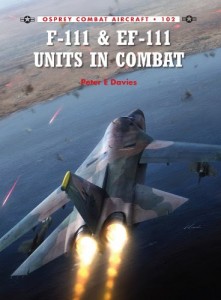Review F-111 & EF-111 Units in Combat- Peter E. Davies
The F-111 Aardvark was designed to substitute the Republic F-105 Thunderchief. The General Dynamics aircraft became operational in the U.S. Air Force in July 1967. Depending on who you talk to, the F-111 was either a great airplane or something of a nuisance.
From the beginning of its development, the F-111 encountered more problems than most new airplane designs must surpass. Part of the problem was that both, the U.S. Air Force and the navy, had their sights set on the F-111 as performing according to their own specifications. In short, the F-111 was to be a fighter, a strategic bomber and a tactical fighter-bomber all wrapped up into one airplane. The F-111 could carry conventional and nuclear weapons and had a range of 3,565 miles. By the time the F-111 was retired from service by the Royal Australian Air Force in 2010, it was all those things in addition to being a fine reconnaissance aircraft. A total of 563 F-111 were built.
Peter E Davies chronicles the growing pains and accomplishments of the F-111 in F-111 &EF Units in Combat. The Aardvark enjoyed a successful operational history in the Vietnam War and the Desert Storm campaign. The F-111 was modified several times in order to satisfy the demands of the many roles that it was asked to perform. In essence, the Aardvark’s ability to be re-configured is the most important aspect of this aircraft.
Part of the appeal for readers of Davies’ book is witnessing how pilots, the many modifications that the aircraft underwent, and its eventual settling into aviation history, given the initial luke-warm reception that the F-111 received, played out. The narrative of the F-111 reads like a drama of man and machine.
Undoubtedly, the F-111 was an invaluable aircraft for the military units that operated it, even though the Aardvark encountered turmoil and resistance, especially early in its operational life.
The pilots who made the transition from the F-105 to the F-111 were in for a rude awakening. While the Republic F-105 Thunderchief was a single-pilot aircraft, the F-111 included a Weapons System Officer (WSO), given the airplane’s complex navigational and advanced radar system. This was fine as long as there were enough trained WSO officers to fill the job. However, when these became scarce, pilots were assigned to the right seat as PWSO officers (Pilot Weapons System Officer). Discontent quickly spread through the pilot community of the F-111. Many pilots who were assigned the PWSO job attempted to resign from the military.
The main responsibility of the WSO officer in the F-111 was to monitor the Terrain-Following Radar (TFR). The TFR system was developed to guide the F-111 through low-level, terrain-hugging missions at night. At first, the TPR system was hair-raising, until pilots began to adjust to its capabilities and began to trust it.
The F-111 had variable-sweep wings that made it possible for the aircraft to land on carriers and fly at supersonic flight when the wings were swept back. The aircraft could exceed 1,650 mph and had an absolute ceiling of 60,000 feet.
During Desert Storm, the F-111’s TFR system proved invaluable against Saddam Hussein’s military. The F-111’s precision bombing at low-level flight was successful because of its cover in darkness while flying at high speed through the desert.
Given the F-111’s rocky beginning, Peter E. Davies ends the book with an appropriately informative chapter entitled “RAAF and the F-111 Legacy.” The F-111, Davies goes on to to add, was influential in the development of the F-14 Tomcat, Panavia Tornado and the Sukhoi Su-24 Fencer.












Leave a Reply